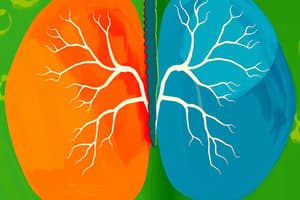Podcast
Questions and Answers
What is the primary function of the cell body in a motor neuron?
What is the primary function of the cell body in a motor neuron?
- It conducts impulses away from the cell body.
- It contains the nucleus and synthesizes proteins and neurotransmitters. (correct)
- It provides insulation around the axon.
- It carries impulses from other neurons towards the axon.
Which component of a motor neuron is responsible for carrying impulses toward the cell body?
Which component of a motor neuron is responsible for carrying impulses toward the cell body?
- Myelin sheath
- Dendrites (correct)
- Axon
- Nodes of Ranvier
What role does the myelin sheath play in nerve conduction?
What role does the myelin sheath play in nerve conduction?
- It promotes the growth of new neurons.
- It carries impulses directly to muscle fibers.
- It releases neurotransmitters at the synapse.
- It speeds up nerve conduction and provides insulation. (correct)
What are the nodes of Ranvier?
What are the nodes of Ranvier?
How do sensory receptors function in terms of energy conversion?
How do sensory receptors function in terms of energy conversion?
What triggers the generation of an action potential along a sensory neuron?
What triggers the generation of an action potential along a sensory neuron?
What is a characteristic difference between relay neurons and other neurons?
What is a characteristic difference between relay neurons and other neurons?
Which of the following options correctly describes a receptor cell?
Which of the following options correctly describes a receptor cell?
What is the primary function of chemoreceptors in taste buds?
What is the primary function of chemoreceptors in taste buds?
Which of the following statements about sodium ion chemoreceptors is true?
Which of the following statements about sodium ion chemoreceptors is true?
What role does cyclic AMP play in the sweet taste pathway?
What role does cyclic AMP play in the sweet taste pathway?
What is the typical resting potential of an axon?
What is the typical resting potential of an axon?
How is an action potential generated in a sensory neuron from a receptor potential?
How is an action potential generated in a sensory neuron from a receptor potential?
What is the role of synapses in memory and learning?
What is the role of synapses in memory and learning?
What effect does the closure of potassium ion channels have on the membrane?
What effect does the closure of potassium ion channels have on the membrane?
Which component is not part of the striated muscle structure?
Which component is not part of the striated muscle structure?
What does the all-or-nothing law describe?
What does the all-or-nothing law describe?
What best describes the structure of a muscle fiber?
What best describes the structure of a muscle fiber?
Which of the following is NOT a taste detected by chemoreceptors in taste buds?
Which of the following is NOT a taste detected by chemoreceptors in taste buds?
What type of taste sensation is associated with umami?
What type of taste sensation is associated with umami?
What is the primary function of the sarcoplasmic reticulum in muscle fibers?
What is the primary function of the sarcoplasmic reticulum in muscle fibers?
How does the frequency of impulses change with varying stimulus intensity?
How does the frequency of impulses change with varying stimulus intensity?
What is the role of the M line in a sarcomere?
What is the role of the M line in a sarcomere?
Why does action potential amplitude remain constant along the axon?
Why does action potential amplitude remain constant along the axon?
What is the primary function of the sarcoplasmic reticulum in muscle contraction?
What is the primary function of the sarcoplasmic reticulum in muscle contraction?
What role do T-tubules play in muscle fibers?
What role do T-tubules play in muscle fibers?
What event causes the myosin binding sites on actin filaments to become exposed?
What event causes the myosin binding sites on actin filaments to become exposed?
Which component primarily forms the thick filaments in muscle fibers?
Which component primarily forms the thick filaments in muscle fibers?
What is the function of tropomyosin in muscle fibers?
What is the function of tropomyosin in muscle fibers?
Which structure is NOT part of a sarcomere?
Which structure is NOT part of a sarcomere?
What initiates the process of muscle contraction at the neuromuscular junction?
What initiates the process of muscle contraction at the neuromuscular junction?
Which protein component is responsible for the energy release during muscle contraction?
Which protein component is responsible for the energy release during muscle contraction?
What is the main function of sensory receptor cells in the detection of stimuli?
What is the main function of sensory receptor cells in the detection of stimuli?
Which structure is crucial for the fast transmission of nerve impulses in myelinated neurons?
Which structure is crucial for the fast transmission of nerve impulses in myelinated neurons?
What role do calcium ions play in the functioning of a cholinergic synapse?
What role do calcium ions play in the functioning of a cholinergic synapse?
Which part of the reflex arc is responsible for transmitting information to muscles?
Which part of the reflex arc is responsible for transmitting information to muscles?
In the sliding filament model of muscular contraction, which proteins are primarily involved?
In the sliding filament model of muscular contraction, which proteins are primarily involved?
What is the primary effect of auxin on plant cells during growth?
What is the primary effect of auxin on plant cells during growth?
What is the main function of the sarcoplasmic reticulum in striated muscle contraction?
What is the main function of the sarcoplasmic reticulum in striated muscle contraction?
How does the myelin sheath affect the frequency of nerve impulses?
How does the myelin sheath affect the frequency of nerve impulses?
Study Notes
Communication Systems
- Nervous and endocrine systems coordinate responses to internal and external changes.
- The nervous system is fast, using electrical impulses, while the endocrine system relies on hormones for slower responses.
Neuron Structure
- Sensory Neurons: Transmit impulses from sensory receptors to the CNS.
- Motor Neurons: Carry impulses from the CNS to effectors.
- Relay Neurons: Connect sensory and motor neurons within the CNS.
Sensory Receptor Cells
- Detect stimuli and stimulate nerve impulse transmission.
- Example: Chemoreceptor cells in human taste buds respond to chemical stimuli.
Reflex Arc Functions
- Sensory neurons detect stimuli, relay neurons process information, and motor neurons execute responses.
Action Potential Transmission
- Initiated from resting potential (-60 to -70 mV).
- Sodium (Na⁺) and potassium (K⁺) ions play crucial roles in impulse transmission.
- Myelinated neurons increase impulse speed through saltatory conduction.
Myelin Sheath
- Formed by Schwann cells wrapping around axons, aiding speed and insulation.
- Nodes of Ranvier are crucial for rapid impulse transmission.
Cholinergic Synapse Structure
- Involves neurotransmitter release, with calcium ions triggering exocytosis for signal transmission.
Synapse Functions
- Permit unidirectional transmission and facilitate connections between multiple neurons.
Neuromuscular Junctions
- Interfaces between motor neurons and muscle fibers, essential for muscle contraction initiation.
Striated Muscle Structure
- Composed of muscle fibers (syncytium) containing organized contractile proteins.
- Sarcomeres are the fundamental contractile units, structured between Z lines.
Sliding Filament Model
- Myosin and actin filaments slide past each other during contraction.
- Calcium ions bind to troponin, triggering conformational changes that expose binding sites on actin.
Venus Flytrap Mechanism
- Rapid closure in response to hair stimulation, achieving trap closure via fluid movement.
Growth Regulation by Auxin
- Auxin promotes cell elongation by stimulating proton pumps, acidifying cell walls.
Gibberellin Role in Germination
- Gibberellin facilitates germination processes in grains like wheat and barley.
Action Potential Characteristics
- All-or-nothing law: Action potentials occur only if the threshold is surpassed.
- Intensity of stimuli is encoded by the frequency and number of neurons firing, not the magnitude of each action potential.
Structure of Sarcomere
- A Band: Overlapping myosin and actin filaments, darker region.
- I Band: Only actin filaments, lighter region.
- H Band: Myosin only, lighter area within the A band.
- Z Line: Attachment point for actin filaments.
Myosin and Actin Composition
- Myosin: Thick filaments with fibrous protein structure, globular heads for binding.
- Actin: Thin filaments composed of globular proteins twisted together with tropomyosin and troponin.
Mechanism of Muscle Contraction
- Action potentials trigger calcium release from the sarcoplasmic reticulum, facilitating muscle contraction through the sliding filament mechanism involving ATP utilization.
Studying That Suits You
Use AI to generate personalized quizzes and flashcards to suit your learning preferences.
Related Documents
Description
This quiz covers the key concepts from Chapter 1 of A2 Biology, focusing on coordination and response in living organisms. Explore the comparison between the nervous and endocrine systems, and understand how they facilitate communication in response to environmental changes.




